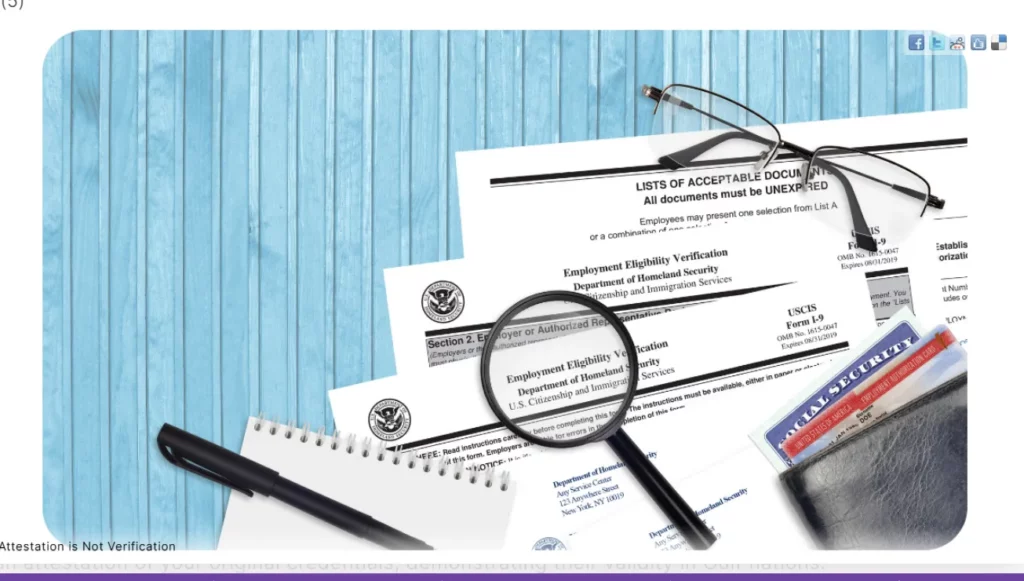Obtaining an Employment Visa, Dependant Visa, Family Visa, or Trade Visa from the Labour Department in Saudi Arabia requires an attestation of your original credentials, demonstrating their validity in Gulf nations.
Let’s explore the difference between verification and attestation to understand why attestation is not the same as verification in the UAE or anywhere else.
What is Attestation?
An attestation is a signed statement from a third party confirming the authenticity of an individual’s identity.
Attestation is the process of confirming the authenticity or validity of a document. It has nothing to do with the content of the document.
In order to verify that a document is authentic, it needs to be attested by an expert or someone who has access to the original document.
What is Verification?
Verification is a confirmation that the information given by an individual is accurate.
Verification is checking and examining documents to ensure they are genuine.
Why do you need attestation and verification?
Both attestations and verifications are used in many different industries for various purposes. You can use them for things like:
- Verifying someone’s identity,
- Confirming that someone has the appropriate qualifications to do certain tasks,
- Checking whether someone has been employed by a company or organization, etc.
The Problem of Falsely Altered Records
The problem is that it is becoming easier to alter or forge documents with the increased use of digital records and data. We often see an increase in the number of cases where papers have been forged or altered.
To combat this problem, we must find ways to attest digital records and ensure that no one can alter them.
The Value of Digital Attestations
Digital attestations are a way to authenticate the authenticity of digital assets. The most common ones are digital signatures and digital certificates.
A digital certificate establishes the identity of an individual, computer system, or organization on the Internet by providing evidence that they hold certain attributes, such as a property right or an educational credential.
Digital certificates are often used to digitally sign files and authenticate access to a network or website with the username and password combinations. Digital certificates also identify a website’s author to prevent someone from impersonating it and intercepting traffic from those who visit the site believing it is genuine.
Attestation in the UAE
All professional and academic credentials issued in different areas of the UAE must first be attested by the Indian Embassy/Consulate in the UAE, followed by the Ministry of Foreign Affairs of the UAE Government before a UAE visa may be issued.
Examples of the type of documents that require attestation:
Both attestations and verifications are used in many different industries for various purposes. You can use them for things like:
- Personal Documents
- Educational materials (certificate & transcripts are viewed as two different papers)
- Birth certificates
- Death certificate
- Medical records
- Good conduct certificate
- Marriage certificate
- Personal power of attorney letters
- Employment contract.
- Contracts also require attestation. Some of these include:
- Commercial registration appointment of management or director
- Minutes of board or partner meetings
- Company name change
- Trademark registration
- Distribution agreement
- Corporate insurance certificate
- Partnership or shareholder certificate
- Bankruptcy paperwork
- And many more.
Legal Paperwork That Must Be Provided for Attestation
Original material should be in either English or Arabic (or an official translation of it). Before submitting a document, ensure the proper authorities have attested it. Also, laminating a document is not allowed.
What is the Attestation Procedure for Documents Issued in the UAE
When it comes to documents issued within the UAE:
- The ruling government entity must attest the original document, with the expeption of digital documents issued by a government entity or papers that have been electronically attested.
- Submit an application for attestation in the United Arab Emirates through the appropriate online MoFAIC channels.
- Include a copy of the original document, even if it is digital or has been authenticated electronically if that is the case.
- The document must be attested by one of the embassies or missions overseas by submitting an application for attestation through our various online channels.
The Attestation Procedure for Documents Issued Outside of the UAE
Documents that were issued outside of the UAE:
- The original document should first be attested by the Ministry of Foreign Affairs of the country that issued the document to use a document that was issued outside the UAE.
- The document can then be authenticated by one of the UAE’sUAE’s embassies or consulates in the issuing nation using the online channels provided by MoFAIC.
- Documents are required to be attested in the UAE, which you can do by submitting an application for attestation in the UAE using our online channels. Please send the unaltered original of the document that was notarized.
In Summary
The term “attestation” is often confused with “verification.” The truth is that they are two different things.
Attested means that the document has been examined and verified by either a notary, public, or government official. It can be used in reference to documents of all types, including birth certificates, marriage licenses, and power of attorney documents. Verified means that an independent third party, such as a notary public or government official, has confirmed the authenticity of a document or statement.
















